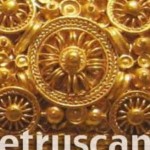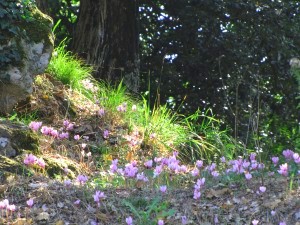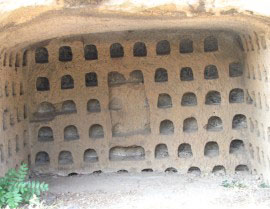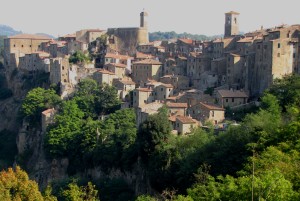 You can imagine the excitement we felt when on a day we set aside for exploring, we stumbled across an old Etruscan cave, with its characteristic little square shelves — niches for storage and baking. We were hiking in a wooded park with patches of luminous wildflowers and a spectacular view of Sorano, one of the many villages on our itinerary off the road leading out of Orvietto.
You can imagine the excitement we felt when on a day we set aside for exploring, we stumbled across an old Etruscan cave, with its characteristic little square shelves — niches for storage and baking. We were hiking in a wooded park with patches of luminous wildflowers and a spectacular view of Sorano, one of the many villages on our itinerary off the road leading out of Orvietto.
The very name Etruscans evokes a distinct allure, with its connection to Tuscany. But, what do we really know about them?
with its connection to Tuscany. But, what do we really know about them?
Try to Imagine Italy in a time long before the Romans, when small settlements dotted the central hill towns and valleys. “Established sites” began to appear between 900 and 750 BC. These unique builders and seafarers became Europe’s most advanced civilization, outside Greece, for 500 years.
They were early masters of metallurgy, faceting beautiful gold jewelry and trading in copper and bronze. This strengthened and enriched the Etruscans and helped to cultivate the civilization’s expansion around the coastal cities of the Mediterranean.
They were great wine makers, evidenced by the grape seeds found at their tomb sites. Much of their time was spent building roads and aqueducts, painting vases and creating impressive lifelike structures.
Much of their time was spent building roads and aqueducts, painting vases and creating impressive lifelike structures.
The life sized pair of winged horses housed at the Tarquinia National Museum is one of the jewels of this ancient culture. We were shocked as we walked into the room that houses this little masterpiece, as it is much smaller than expected. Once an opulent palace,the National Museum at Tarquinia is well worth the visit: it is very accessible and tourist friendly, filled with tombs and artifacts celebrating the great talents of these intriguing people. As the Etruscans were skilled seafarers, much of what we know about their culture was uncovered at Tarquinia, the seaside port perched high upon rocky cliffs.
Around the 4th century BC the younger Roman civilization encountered the Etruscans (the name given to them by the Romans was Etrusci ). They were eventually over shadowed by the Romans and as the Etruscans chose to build primarily in wood and plaster, they were soon absorbed into the Roman culture of stone and marble.
With scholars in disagreement about the exact origin of these fascinating people, who maintained their own unique language and religion, their legacy is abundant in these hill towns of Italy. And although scholars today can only understand a few 100 words in the artifacts left behind, we do know that their writings were commonplace among young Roman schoolboys.
So, now when we gaze upon a piece of the Via Appia or are amazed by the magnificence and scope of Roman builders, we can’t help but think back to this little park. And wonder about whose life this was and how they influenced Roman history.
…Orvietto is a good base from which to explore the Etruscan hilltop towns of Sovana, Sorano, Pitigliano and Saturnia, to name a few. Getting off the beaten path and exploring will guarantee your visit to the Etruscan ruins is unforgettable. Uncovering hidden mysterious tombs and structures rewards you with almost mystical memories. Having a great map is key.


![cavalli_alati_di-Tarquinia[1] etruscan winged horses](http://placesthatspeak.org/wp-content/uploads/2011/02/cavalli_alati_di-Tarquinia1-261x300.jpg)












